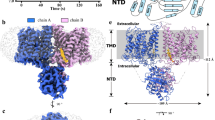Summary
The sulfhydryl reagent 5, 5′-dithiobis (2-nitrobenzoic acid) (DTNB) was used to study the functional role of an exofacial sulfhydryl group on the human erythrocyte hexose carrier. Above 1mm DTNB rapidly inhibited erythrocyte 3-O-methylglucose influx, but only to about half of control rates. Efflux was also inhibited, but to a lesser extent. Uptake inhibition was completely reversed by incubation and washing with 10mm cysteine, whereas it was only partially reduced by washing in buffer alone, suggesting both covalent and noncovalent interactions. The covalent thiol-reversible reaction of DTNB occurred on the exofacial carrier, since (i) penetration of DTNB into cells was minimal, (ii) blockade of potential uptake via the anion transporter did not affect DTNB-induced hexose transport inhibition, and (iii) DTNB protected from transport inhibition by the impermeant sulfhydryl reagent glutathione-maleimide-I. Maltose at 120mm accelerated the covalent transport inhibition induced by DTNB, whereas 6.5 μm cytochalasin B had the opposite effect, indicating under the one-site carrier model that the reactive sulfhydryl is on the outward-facing carrier but not in the substrate-binding site. In contrast to glutathione-maleimide-I, however, DTNB did not restrict the ability of the carrier to reorient inwardly, since it did not affect equilibrium cytochalasin B binding. Thus, carrier conformation determines exposure of the exofacial carrier sulfydryl, but reaction of this group may not always “lock” the carrier in an outward-facing conformation.
Similar content being viewed by others
References
Abbott, R.E., Schachter, D. 1976. Impermeant maleimides. Oriented probes of erythrocyte membrane proteins.J. Biol. Chem. 251:7176–7183
Batt, E.R., Abbott, R.E., Schachter, D. 1976. Impermeant maleimides. Identification of an exofacial component of the human erythrocyte hexose transport mechanism.J. Biol. Chem. 251:7184–7194
Clark, S., Harrison, L.C. 1983. Disulfide exchange between insulin and its receptor. A possible post-binding step in insulin action.J. Biol. Chem. 258:11434–11437
Czech, M.P. 1976. Differential effects of sulfhydryl reagents on activation and deactivation of the fat cell hexose transport system.J. Biol. Chem. 251:1164–1170
Devés, R., Krupka, R.M. 1978. Cytochalasin B and the kinetics of inhibition of biological transport. A case of asymmetric binding to the glucose carrier.Biochim. Biophys. Acta 510:339–348
Gorga, F.R., Lienhard, G.E. 1981. Equilibria and kinetics of ligand binding to the human erythrocyte glucose transporter. Evidence for an alternating conformation model for transport.Biochemistry 20:5108–5113
Hissen, P.J., Hilf, R. 1976. A fluorometric method for determination of oxidized and reduced glutathione in tissues.Anal. Biochem. 74:214–226
Jocelyn, P.C. 1987. Chemical reduction of disulfides.Methods Enzymol. 143:246–256
Krupka, R.M. 1985. Asymmetrical binding of phloretin to the glucose transport system of human erythrocytes.J. Membrane Biol. 83:71–80
Krupka, R.M. 1985. Reaction of the glucose carrier of erythrocytes with sodium tetrathionate: Evidence for inward-facing and outward-facing carrier conformations.J. Membrane Biol. 84:35–43
Krupka, R.M., Devés, R. 1986. Looking for probes of gated channels: Studies of the inhibition of glucose and choline transport in erythrocytes.Biochem. Cell Biol. 64:1099–1107
May, J.M. 1986. Photoafffinity labeling of glyceraldehyde-3-phosphate dehydrogenase by an aryl azide derivative of glucosamine in human erythrocytes.J. Biol. Chem. 261:2542–2547
May, J.M. 1987. Labeling of human erythrocyte band 3 with maltosylisothiocyanate. Interaction with the anion transporter.J. Biol. Chem. 262:3140–3145
May, J.M. 1988. Reaction of an exofacial sulfhydryl group on the erythrocyte hexose carrier with an impermeant maleimide: Relevance to the mechanism of hexose transport.J. Biol. Chem. 263:13635–13640
May, J.M. 1988. Selective labeling of the erythrocyte hexose carrier with a maleimide derivative of glucosamine: Relationship of an exofacial sulfhydryl to carrier conformation and structure.Biochemistry 28:1718–1725
Mueckler, M., Caruso, C., Baldwin, S.A., Panico, M., Blench, I., Morris, H.R., Allard, W.J., Lienhard, G.E., Lodish, H.F. 1985. Sequence and structure of a human glucose transporter.Science 229:941–945
Park, J.-W. 1988. Reaction of s-nitrosogluthione with sulfhydryl groups in protein.Biochem. Biophys. Res. Commun. 152:916–920
Reithmeier, R.A.F. 1983. Inhibition of anion transport in human red blood cells by 5,5′-dithiobis(2-nitrobenzoic acid).Biochim. Biophys. Acta 732:122–125
Roberts, S.J., Tanner, J.A., Denton, R.M. 1982. Properties of N-maleoylmethionine sulphone, a novel impermeant maleimide, and its use in the selective labelling of the erythrocyte glucose-transport system.Biochem. J. 205:139–145
Rosenthal, H.E. 1967. A graphic method for the determination and presentation of binding parameters in complex systems.Anal. Biochem. 20:525–532
Smith, R.P.P., Ellman, G.L. 1973. A study of the dependence of the human erythrocyte glucose transport system on membrane sulfhydryl groups.J. Membrane Biol. 12:177–188
Toon, M.R., Dorogi, P.L., Lukacovic, M.F., Solomon, A.K. 1985. Binding of DTNB to band 3 in the human red cell membrane.Biochim. Biophys. Acta 818:158–178
Van Steveninck, J., Weed, R.I., Rothstein, A. 1965. Localization of erythrocyte membrane sulfhydryl groups essential for glucose transport.J. Gen. Physiol. 48:617–632
Vidaver, G.A. 1966. Inhibition of parallel flux and augmentation of counter flux shown by transport models not involving a mobile carrier.J. Theor. Biol. 10:301–306
Author information
Authors and Affiliations
Rights and permissions
About this article
Cite this article
May, J.M. Inhibition of hexose transport in the human erythrocyte by 5, 5′-dithiobis(2-nitrobenzoic acid): Role of an exofacial carrier sulfhydryl group. J. Membrain Biol. 108, 227–233 (1989). https://doi.org/10.1007/BF01871737
Received:
Revised:
Issue Date:
DOI: https://doi.org/10.1007/BF01871737




